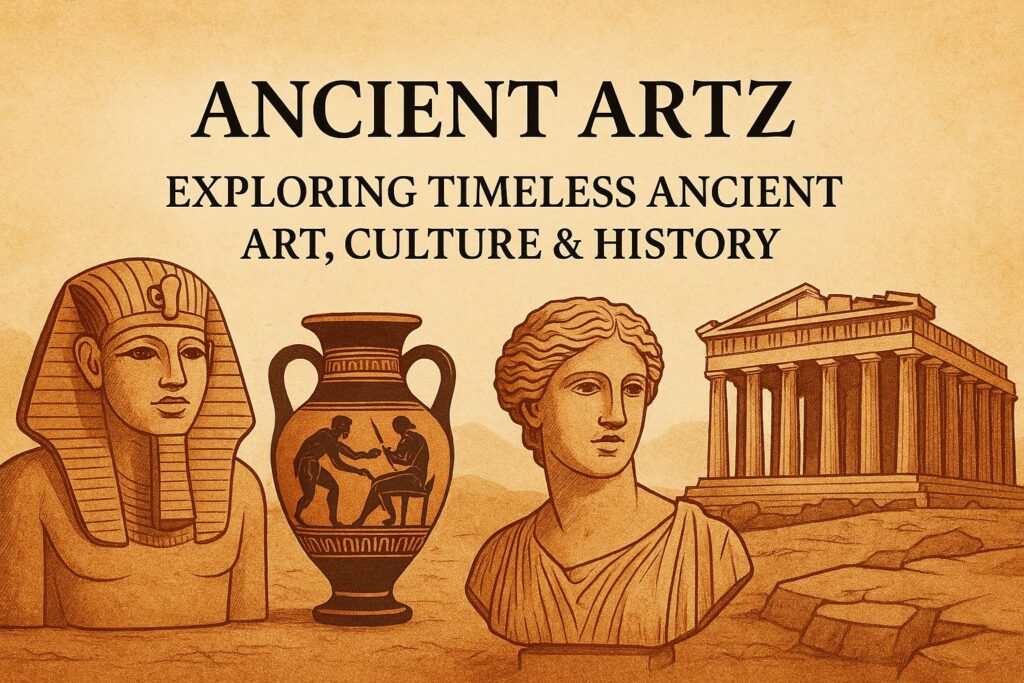In a world dominated by digital media and fleeting trends, there’s something deeply grounding about ancient art. From the intricate cave paintings of early humans to the colossal stone temples of lost empires, Ancient Artz is more than just historical curiosity—it’s a window into the soul of humanity.
Join us as we embark on a journey through timeless art, culture, and history, where every brushstroke, carving, and symbol tells a story of who we were… and who we still are.
🏛️ What is Ancient Artz?
Ancient Artz refers to the artistic expressions and cultural symbols created by civilizations long before the modern era. These include visual art, sculpture, architecture, pottery, textiles, music, and written language—often interwoven with spiritual or ceremonial meaning.
While each culture left a unique mark, they all shared a deep connection to storytelling, symbolism, and legacy. From ancient Mesopotamia to the Indus Valley, art was a way to communicate, preserve beliefs, and immortalize power and divinity.
🎨 The Visual Language of Ancient Civilizations
1. Prehistoric Art: Humanity’s First Canvas
-
Cave Paintings (c. 30,000 BCE – 10,000 BCE)
Found in places like Lascaux (France) and Altamira (Spain), these early images of animals and hunting scenes reveal that even prehistoric humans had a sense of aesthetics, spirituality, and symbolism. -
Petroglyphs & Rock Carvings
Used by tribes across Africa, Asia, and the Americas, these etched symbols recorded stories, astronomy, and rituals.
2. Egyptian Art: Eternal Life in Symbolism
-
Characterized by flat, stylized figures and hieroglyphics, Egyptian art was deeply spiritual.
-
Wall paintings, statues, and tomb relics were made to accompany pharaohs in the afterlife.
-
Common motifs: Ankh (life), Eye of Horus (protection), scarabs (rebirth).
3. Greco-Roman Art: Harmony, Realism, and Power
-
Greek art introduced naturalism and anatomical perfection (see: Venus de Milo, Discobolus).
-
Romans inherited Greek techniques but expanded them with mosaics, frescos, and grand architecture like the Colosseum and Pantheon.
4. Indian & Southeast Asian Art: Spiritual Symbolism
-
Ancient India’s art is inseparable from Hinduism and Buddhism, seen in temple carvings, sculptures of deities, and mandalas.
-
In Southeast Asia, sites like Angkor Wat and Borobudur reflect a blend of divine mythology and intricate craftsmanship.
🌐 Cultural Identity Through Art
Art wasn’t just decorative—it shaped and reflected cultural identity.
-
Mesoamerican Cultures (Maya, Aztec, Olmec) created stone pyramids, ceremonial masks, and codices rich in religious symbolism.
-
African Tribal Art conveyed social status, spirituality, and ancestral connection through masks, beadwork, and wooden sculptures.
-
Chinese Dynasties perfected porcelain, calligraphy, and silk painting as forms of philosophical and imperial expression.
Every brushstroke, pattern, and design told a story—often one that was passed down for centuries.
🧠 Ancient Art as Historical Record
Ancient art is not just beautiful—it’s one of our oldest forms of storytelling and recordkeeping. Before the written word became widespread, people carved history into stone, painted it on walls, and passed it down through oral and visual tradition.
-
Hieroglyphs recorded religious texts, laws, and royal decrees.
-
Terracotta armies documented power and belief in the afterlife.
-
Mosaics showed everyday life, myths, and imperial triumphs.
Through art, we learn not only what ancient civilizations built—but also why they lived the way they did.
🔍 What Makes Ancient Art Timeless?
So why does ancient art still captivate us?
-
Universality: Themes of love, death, divinity, and nature echo across time.
-
Mystery: Many artworks come from lost or partially understood cultures—like the Nazca Lines or the statues of Easter Island.
-
Craftsmanship: Despite lacking modern tools, ancient artists achieved astonishing levels of detail and precision.
-
Meaning: Unlike much modern art, ancient art often had clear cultural or spiritual intent, giving it weight and purpose.
“To study ancient art is to study humanity itself—our fears, our beliefs, our hopes, and our creativity.”
🏺 Preserving Ancient Artz in the Modern Age
As time, weather, and conflict threaten ancient heritage, preservation has become a global mission.
-
UNESCO World Heritage Sites protect sacred art locations.
-
Digital reconstructions and VR museums make ancient sites accessible to all.
-
Archaeologists and cultural institutions are restoring damaged works using cutting-edge technology.
But the most important way to preserve Ancient Artz? Keep the stories alive. Share them. Study them. Celebrate them.
🌟 Final Thoughts
Ancient Artz is a timeless journey through humanity’s most profound creations. It’s the silent voice of civilizations past, still whispering to us through stone, color, and symbol.
Whether you’re a history lover, an art enthusiast, or just curious about our collective roots, exploring ancient art opens your mind to new perspectives—and connects you to an unbroken chain of human creativity.
So next time you see a piece of ancient art, don’t just look—listen to the story, feel the texture, and imagine the hands that created it thousands of years ago.

